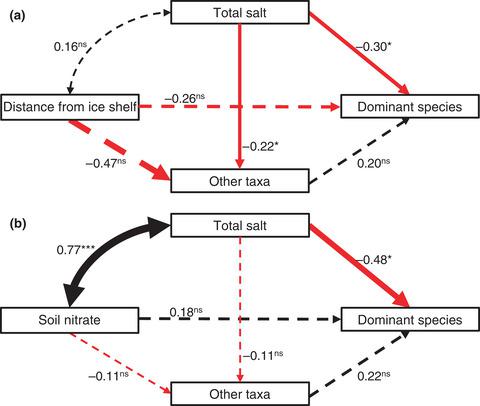当前位置:
X-MOL 学术
›
Glob. Change Biol.
›
论文详情
Our official English website, www.x-mol.net, welcomes your feedback! (Note: you will need to create a separate account there.)
Response of Antarctic soil fauna to climate-driven changes since the Last Glacial Maximum
Global Change Biology ( IF 11.6 ) Pub Date : 2021-10-17 , DOI: 10.1111/gcb.15940 André L C Franco 1 , Byron J Adams 2 , Melisa A Diaz 3 , Nathan P Lemoine 4, 5 , Nicholas B Dragone 6 , Noah Fierer 6 , W Berry Lyons 3 , Ian Hogg 7, 8 , Diana H Wall 9
Global Change Biology ( IF 11.6 ) Pub Date : 2021-10-17 , DOI: 10.1111/gcb.15940 André L C Franco 1 , Byron J Adams 2 , Melisa A Diaz 3 , Nathan P Lemoine 4, 5 , Nicholas B Dragone 6 , Noah Fierer 6 , W Berry Lyons 3 , Ian Hogg 7, 8 , Diana H Wall 9
Affiliation

|
Understanding how terrestrial biotic communities have responded to glacial recession since the Last Glacial Maximum (LGM) can inform present and future responses of biota to climate change. In Antarctica, the Transantarctic Mountains (TAM) have experienced massive environmental changes associated with glacial retreat since the LGM, yet we have few clues as to how its soil invertebrate-dominated animal communities have responded. Here, we surveyed soil invertebrate fauna from above and below proposed LGM elevations along transects located at 12 features across the Shackleton Glacier region. Our transects captured gradients of surface ages possibly up to 4.5 million years and the soils have been free from human disturbance for their entire history. Our data support the hypothesis that soils exposed during the LGM are now less suitable habitats for invertebrates than those that have been exposed by deglaciation following the LGM. Our results show that faunal abundance, community composition, and diversity were all strongly affected by climate-driven changes since the LGM. Soils more recently exposed by the glacial recession (as indicated by distances from present ice surfaces) had higher faunal abundances and species richness than older exposed soils. Higher abundances of the dominant nematode Scottnema were found in older exposed soils, while Eudorylaimus, Plectus, tardigrades, and rotifers preferentially occurred in more recently exposed soils. Approximately 30% of the soils from which invertebrates could be extracted had only Scottnema, and these single-taxon communities occurred more frequently in soils exposed for longer periods of time. Our structural equation modeling of abiotic drivers highlighted soil salinity as a key mediator of Scottnema responses to soil exposure age. These changes in soil habitat suitability and biotic communities since the LGM indicate that Antarctic terrestrial biodiversity throughout the TAM will be highly altered by climate warming.
中文翻译:

自末次盛冰期以来南极土壤动物群对气候驱动变化的响应
了解自末次盛冰期 (LGM) 以来陆地生物群落如何应对冰川衰退可以为生物群现在和未来对气候变化的反应提供信息。在南极洲,自 LGM 以来,横贯南极山脉 (TAM) 经历了与冰川退缩相关的巨大环境变化,但我们对其以土壤无脊椎动物为主的动物群落如何反应知之甚少。在这里,我们沿着位于沙克尔顿冰川地区 12 个特征的横断面,从拟定 LGM 海拔的上方和下方调查了土壤无脊椎动物群。我们的横断面捕获了可能长达 450 万年的地表年龄梯度,并且土壤在其整个历史中都没有受到人类干扰。我们的数据支持这样一个假设,即 LGM 期间暴露的土壤现在比 LGM 之后因冰川消融而暴露的土壤更不适合无脊椎动物的栖息地。我们的结果表明,自 LGM 以来,动物群落丰度、群落组成和多样性都受到气候驱动变化的强烈影响。最近因冰川退缩而暴露的土壤(如与现有冰面的距离所示)比旧暴露的土壤具有更高的动物群丰度和物种丰富度。优势线虫的丰度更高 最近因冰川退缩而暴露的土壤(如与现有冰面的距离所示)比旧暴露的土壤具有更高的动物群丰度和物种丰富度。优势线虫的丰度更高 最近因冰川退缩而暴露的土壤(如与现有冰面的距离所示)比旧暴露的土壤具有更高的动物群丰度和物种丰富度。优势线虫的丰度更高Scottnema被发现在较旧的暴露土壤中,而Eudorylaimus、Plectus、缓步动物和轮虫优先出现在最近暴露的土壤中。大约 30% 的可以提取无脊椎动物的土壤中只有Scottnema,并且这些单分类群落更频繁地出现在暴露时间较长的土壤中。我们对非生物驱动因素的结构方程模型强调了土壤盐分是Scottnema对土壤暴露年龄反应的关键介质。自 LGM 以来土壤栖息地适宜性和生物群落的这些变化表明,整个 TAM 的南极陆地生物多样性将因气候变暖而发生重大变化。
更新日期:2021-12-13
中文翻译:

自末次盛冰期以来南极土壤动物群对气候驱动变化的响应
了解自末次盛冰期 (LGM) 以来陆地生物群落如何应对冰川衰退可以为生物群现在和未来对气候变化的反应提供信息。在南极洲,自 LGM 以来,横贯南极山脉 (TAM) 经历了与冰川退缩相关的巨大环境变化,但我们对其以土壤无脊椎动物为主的动物群落如何反应知之甚少。在这里,我们沿着位于沙克尔顿冰川地区 12 个特征的横断面,从拟定 LGM 海拔的上方和下方调查了土壤无脊椎动物群。我们的横断面捕获了可能长达 450 万年的地表年龄梯度,并且土壤在其整个历史中都没有受到人类干扰。我们的数据支持这样一个假设,即 LGM 期间暴露的土壤现在比 LGM 之后因冰川消融而暴露的土壤更不适合无脊椎动物的栖息地。我们的结果表明,自 LGM 以来,动物群落丰度、群落组成和多样性都受到气候驱动变化的强烈影响。最近因冰川退缩而暴露的土壤(如与现有冰面的距离所示)比旧暴露的土壤具有更高的动物群丰度和物种丰富度。优势线虫的丰度更高 最近因冰川退缩而暴露的土壤(如与现有冰面的距离所示)比旧暴露的土壤具有更高的动物群丰度和物种丰富度。优势线虫的丰度更高 最近因冰川退缩而暴露的土壤(如与现有冰面的距离所示)比旧暴露的土壤具有更高的动物群丰度和物种丰富度。优势线虫的丰度更高Scottnema被发现在较旧的暴露土壤中,而Eudorylaimus、Plectus、缓步动物和轮虫优先出现在最近暴露的土壤中。大约 30% 的可以提取无脊椎动物的土壤中只有Scottnema,并且这些单分类群落更频繁地出现在暴露时间较长的土壤中。我们对非生物驱动因素的结构方程模型强调了土壤盐分是Scottnema对土壤暴露年龄反应的关键介质。自 LGM 以来土壤栖息地适宜性和生物群落的这些变化表明,整个 TAM 的南极陆地生物多样性将因气候变暖而发生重大变化。



























 京公网安备 11010802027423号
京公网安备 11010802027423号